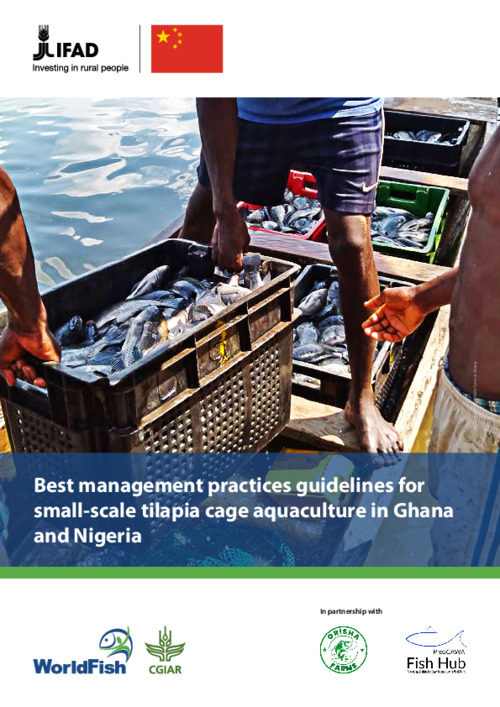Best Management Practices guidelines for small scale tilapia cage aquaculture in Ghana and Nigeria

Africa accounts for about 7% of the world’s total fish production (FAO 2020). Nile tilapia (Oreochromis niloticus), a native of Africa, is the third-most farmed fish species in the world (FAO 2020) and is consumed worldwide (Asiedu et al. 2015). Because of market demand and the availability of suitable water bodies, Nigeria and Ghana have enormous potential for tilapia aquaculture, particularly in cages (Njoku et al. 2022).
Cage aquaculture refers to rearing captive fish within a floating enclosure in a water body. Typically, the
enclosure is encircled on all sides, with mesh netting that corresponds to the size of the fish in the cage.
Floats keep the cage buoyant, sinkers at the base of the cage keep the water column stable, an anchor
system is used for mooring, and walkways are used to maneuver around the cage. Cage aquaculture has several advantages over other forms of conventional aquaculture. The velocity of the water flowing through and past the cages flushes out waste, allowing more fingerlings to be stocked than in ponds. The enclosed nature reduces the risk of predation by animals such as birds (fish eagles, cormorants and kingfishers, among others), snakes, monitor lizards and crocodiles. Harvesting fish from cages is also relatively easier. However, a significant issue with small-scale fish farmers in Africa has been the lack of adequate training and well-trained staff to operate such farms and the limited availability of extension services to assist distressed farmers.In addition, most farmers have jumped on the
bandwagon because of promises of enormous profits and hearsay without proper planning or preparation,
resulting in losses and failed businesses. A farmer can incur significant losses because of poor management
practices that result in overstocking, escapes, poor water quality, overfeeding, negligent security, disease
outbreaks and inadequate recordkeeping. More than ever, the recent boom in the sector means that
training is needed to apply the best principles in farm management and help mitigate losses to farmers. The
remaining sections in this manual lay out the guidelines for best management practices for your tilapia cage
aquaculture venture.
Permalink
Date Available
Type
Publisher
Copyright
CC-BY-NC-4.0
Research Themes
Language